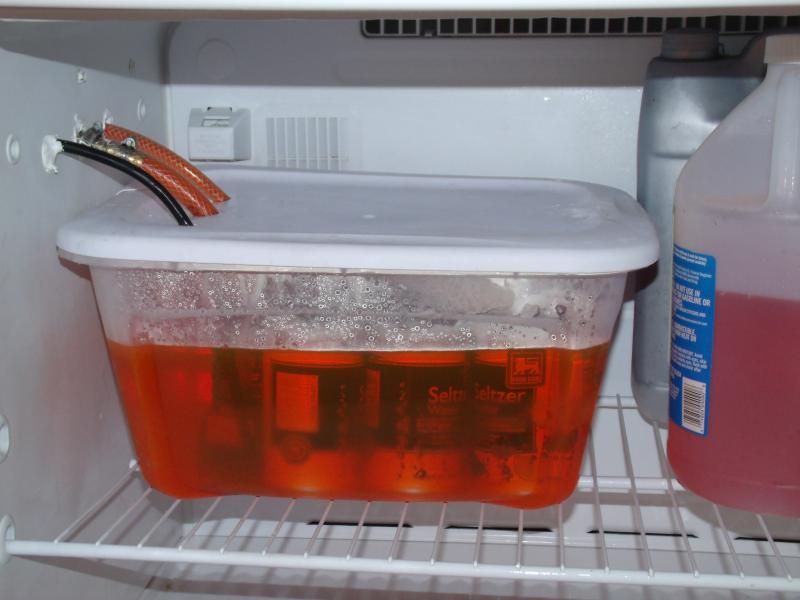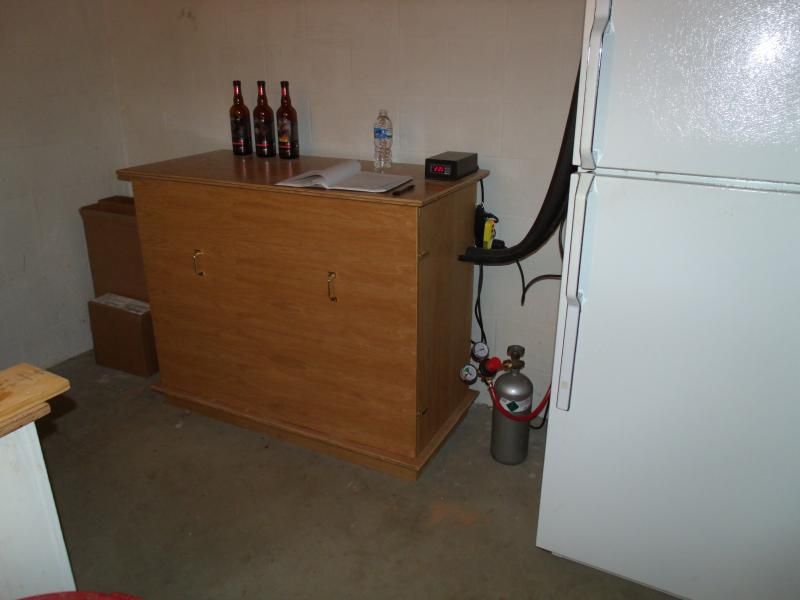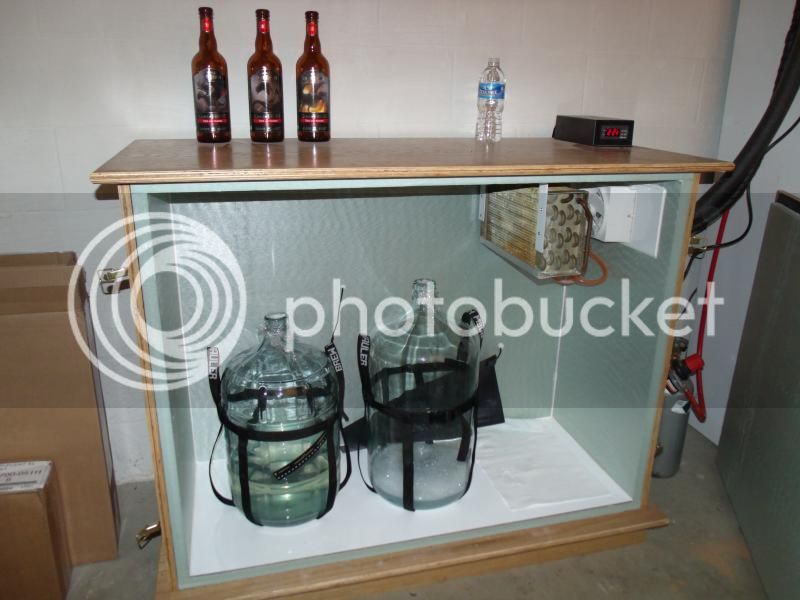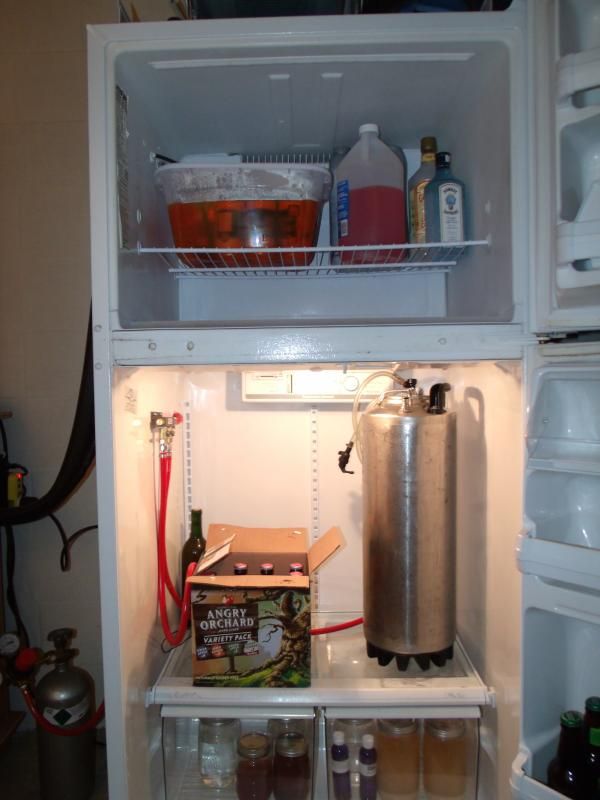You are using an out of date browser. It may not display this or other websites correctly.
You should upgrade or use an alternative browser.
You should upgrade or use an alternative browser.
Heat exchange ferm chamber
- Thread starter riderkb
- Start date

Help Support Homebrew Talk - Beer, Wine, Mead, & Cider Brewing Discussion Forum:
This site may earn a commission from merchant affiliate
links, including eBay, Amazon, and others.
riderkb
Well-Known Member
riderkb
Well-Known Member
riderkb
Well-Known Member
A close up of the glycol tank. The circulation pump is made for a fountain; I got it at Lowes. The soda cans are full of RV antifreeze, which actually does freeze, it just doesn't freeze solid. It sort of makes slush inside the soda cans. The melting slush gives the tank a higher effective heat capacity so that it can pull down the temperature of the chamber faster after a heat spike like when you open the door.
I like this set up because it gives me a freezer to store hops, a fridge to serve kegs, and a ferm chamber.
My basement is about 80F in the summer and 55F in the winter. The chamber can do ales year-round; I like to use S-04 at 16C for my house yeast. I've never done a lager, but I did test it out for that. During the winter I can do lager ferm temps with no problem.

I like this set up because it gives me a freezer to store hops, a fridge to serve kegs, and a ferm chamber.
My basement is about 80F in the summer and 55F in the winter. The chamber can do ales year-round; I like to use S-04 at 16C for my house yeast. I've never done a lager, but I did test it out for that. During the winter I can do lager ferm temps with no problem.

Stealthcruiser
Well-Known Member
Sub'd, so I can find it!
A close up of the glycol tank. The circulation pump is made for a fountain; I got it at Lowes. The soda cans are full of RV antifreeze, which actually does freeze, it just doesn't freeze solid. It sort of makes slush inside the soda cans. The melting slush gives the tank a higher effective heat capacity so that it can pull down the temperature of the chamber faster after a heat spike like when you open the door.
I like this set up because it gives me a freezer to store hops, a fridge to serve kegs, and a ferm chamber.
My basement is about 80F in the summer and 55F in the winter. The chamber can do ales year-round; I like to use S-04 at 16C for my house yeast. I've never done a lager, but I did test it out for that. During the winter I can do lager ferm temps with no problem.
What is the difference between the glycol in the bin and that in the cans? How can it freeze in the cans, but not in the bin?
I've got a converted dehumidifier as my glycol chiller, and when I got below about 26F with the glycol I had problems with slush forming on the evaporator. A high flow pump keeping it moving could help, but I had to change to bigger pumps for my lager chiller jackets, and can't fit an extra pump anymore. The glycol is set to -1C +/-1, and it drops to -3.8C (25F) after the compressor shuts off and it stabilizes. The sensor is not very close to the evaporator though.
I tried to cool the 13x13x24 chamber to lager temps, but he heat exchanger froze up from condensate, and never got below about 42. Switched to insulated "jackets" around the carboy using tubing, flashing and reflectix, and that works great.
I can keep 2 carboys at 37F, with glycol at 26-30F and ambient about 70F. I tried to go to 35, but at the current glycol temp the pumps ran almost non-stop. I have a full 3 gallons in the system.
It is full strength "minus 50" protection glycol. Slushed up good on the back porch during the polar vortex last winter, when I "tested" it. It was mid teens that night.
riderkb
Well-Known Member
The working fluid is undiluted automotive antifreeze. I don't monitor it's temp, but it is well below freezing. The stuff in the cans is RV antifreeze, which is alcohol, glycerin, and water. It grows ice crystals and gets slushy, but won't freeze solid and break stuff. Maybe it would work just as well with plain water in the cans or no cans at all.
When you run a jacketed tank system does the circulator pump run all the time? Seems like it should and that would prevent the working fluid from freezing up in the heat exchanger.
When you run a jacketed tank system does the circulator pump run all the time? Seems like it should and that would prevent the working fluid from freezing up in the heat exchanger.
The working fluid is undiluted automotive antifreeze. I don't monitor it's temp, but it is well below freezing. The stuff in the cans is RV antifreeze, which is alcohol, glycerin, and water. It grows ice crystals and gets slushy, but won't freeze solid and break stuff. Maybe it would work just as well with plain water in the cans or no cans at all.
When you run a jacketed tank system does the circulator pump run all the time? Seems like it should and that would prevent the working fluid from freezing up in the heat exchanger.
Normally everyone uses the RV antifreeze as it it non-poisonous, automotive type is highly poisonous and a pet hazard (if you have any).
My pumps only run as needed to maintain the carboy temp. The glycol tank/evaporator is set at about 26F, and it will not slush at this temp. I had it a little lower, and did get some slush on the evaporator when there was no flow.
You can see my build details starting here.
riderkb
Well-Known Member
I looked through your jacketed fermenter build thread. Very cool. I can see why you might worry about spilling coolant if you have to unhook the tubes each time you move a carboy.
In my chamber the tubing is permanent, so there is less spillage risk. Using auto antifreeze lets me get the ferm chamber down to about 10 or 12C in the winter, which also happens to be the highest temp I can get in the fridge. In principle I could step a lager all the way down from ferm temp to lager temp, but I haven't done one yet.
In my chamber the tubing is permanent, so there is less spillage risk. Using auto antifreeze lets me get the ferm chamber down to about 10 or 12C in the winter, which also happens to be the highest temp I can get in the fridge. In principle I could step a lager all the way down from ferm temp to lager temp, but I haven't done one yet.
I looked through your jacketed fermenter build thread. Very cool. I can see why you might worry about spilling coolant if you have to unhook the tubes each time you move a carboy.
The jacket opens in the front, and is secured with a stretchy velcro strap. No need to disconnect hoses, although they do have disconnects if needed.
As I do more lagers I'll see how well they work without disconnecting. It's a very snug fit in the space, and the second one I made is tighter yet. It was a bit of a pain to get the velcro around it and secured. The first one does not have the disconnects installed yet. I 'hard hosed' it at first, then changed the design for the second. The 2 upper chambers have mini radiators also with disconnects for ease of removal, if needed. The fans on them are cheap, and I've had 2 fail so far.
The stuff in the cans is RV antifreeze, which is alcohol, glycerin, and water.
This part of your message just registered with me.... My understanding from lots of posts here on HBT was that Marine/RV antifreeze is propylene glycol. Turns out the -50 stuff is just what you posted! You need the -100 stuff to get propylene glycol. That explains the vast price difference I suppose.
Now I have to wonder how much ethanol will evaporate from my unsealed system. At 26F I'll bet it's slow. But at $4/gal vs $30/gal, I can replace it cheaper. I did see 1 brand of -100 (Starbrite) at $10/gal.
riderkb
Well-Known Member
This part of your message just registered with me.... My understanding from lots of posts here on HBT was that Marine/RV antifreeze is propylene glycol. Turns out the -50 stuff is just what you posted! You need the -100 stuff to get propylene glycol. That explains the vast price difference I suppose.
Now I have to wonder how much ethanol will evaporate from my unsealed system. At 26F I'll bet it's slow. But at $4/gal vs $30/gal, I can replace it cheaper. I did see 1 brand of -100 (Starbrite) at $10/gal.
I don't know about the ethanol, but the water used to evaporate in mine and redeposit as frost on the underside of the lid. I have the tops of the cans loosely covered now, which fixed the problem.
I don't know about the ethanol, but the water used to evaporate in mine and redeposit as frost on the underside of the lid. I have the tops of the cans loosely covered now, which fixed the problem.
Just looked in my reservoir and the loops of tubing across the top of the evaporator are encased in an ice formation. Must be the water that tried to evaporate!
KatoBaggins
Well-Known Member
...In my chamber the tubing is permanent, so there is less spillage risk. Using auto antifreeze lets me get the ferm chamber down to about 10 or 12C in the winter, which also happens to be the highest temp I can get in the fridge. In principle I could step a lager all the way down from ferm temp to lager temp, but I haven't done one yet.
What heater core is that? It seems really thick for an automobile. And do you know how many CFM the fan runs at? I'm interested in doing something like this with a dual chamber. One side for ale and one side for lager, and a larger glycol tank to run both. I would have expected you to be able to get colder than 10°C with your setup.
riderkb
Well-Known Member
What heater core is that? It seems really thick for an automobile. And do you know how many CFM the fan runs at? I'm interested in doing something like this with a dual chamber. One side for ale and one side for lager, and a larger glycol tank to run both. I would have expected you to be able to get colder than 10°C with your setup.
I don't know what the core was from. It was the wrong size for a friends project car, so he gave it to me. The fan is from a broken microwave, so it is pretty wimpy.
Going lower than 10C would probably require another layer of foam insulation. It would also work better if the glycol tank was metal and had a lot more surface area. You might even use an automobile radiator in the freezer.
KatoBaggins
Well-Known Member
I don't know what the core was from. It was the wrong size for a friends project car, so he gave it to me. The fan is from a broken microwave, so it is pretty wimpy.
Going lower than 10C would probably require another layer of foam insulation. It would also work better if the glycol tank was metal and had a lot more surface area. You might even use an automobile radiator in the freezer.
Thanks for the info. I'll start a build thread when I get going. Glad you posted yours. It's been very inspirational.

spittybug
Well-Known Member
I was thinking of just moving air in/out of a ferm chamber from my refrigerator sitting next to it, but your solution may be better.
My big question is in the drilling of the holes into the side of the freezer. How did you check for coolant lines and avoid them? I've always been under the assumption that the freezer is surrounded by them (except door). Am I wrong? Is it just the back wall that has them?
I wonder if finding a larger radiator for the ferm chamber would help. It could be mounted to the ceiling and "drop" the cold (I know, the heat moves.....) uniformly onto the carboys... You are drawing the warm air across the coils rather than trying to "blow cold air", right?
My big question is in the drilling of the holes into the side of the freezer. How did you check for coolant lines and avoid them? I've always been under the assumption that the freezer is surrounded by them (except door). Am I wrong? Is it just the back wall that has them?
I wonder if finding a larger radiator for the ferm chamber would help. It could be mounted to the ceiling and "drop" the cold (I know, the heat moves.....) uniformly onto the carboys... You are drawing the warm air across the coils rather than trying to "blow cold air", right?
riderkb
Well-Known Member
I was thinking of just moving air in/out of a ferm chamber from my refrigerator sitting next to it, but your solution may be better.
My big question is in the drilling of the holes into the side of the freezer. How did you check for coolant lines and avoid them? I've always been under the assumption that the freezer is surrounded by them (except door). Am I wrong? Is it just the back wall that has them?
I wonder if finding a larger radiator for the ferm chamber would help. It could be mounted to the ceiling and "drop" the cold (I know, the heat moves.....) uniformly onto the carboys... You are drawing the warm air across the coils rather than trying to "blow cold air", right?
I just drilled through the sheet metal and poked around in the foam to see if there was a coolant line in the way. There wasn't, so I drilled the rest of the way through.
Using big radiators in the freezer and the ferm chamber is a good idea, but it won't do any good to use a big one in the chamber and a small one in the freezer. The lowest temp is limited by how cold the fluid gets in one lap through the circuit. If the freezer heat exchanger is too small the fluid will go in cool and come out just slightly cooler.
spittybug
Well-Known Member
Thanks RiderKB. I stopped by an appliance repair center yesterday and asked some questions. The guy told me that on the newer generation refrigerators (unspecified age, but within 20 years or so I think), the cooling lines are only on the back walls and/or through the dividing shelf between the freezer and the refrigerator. So, I'm good to go for cutting through the side of the freezer section.
Air is a far less efficient means of moving warmth than direct contact with liquid. That said, whether using a glycol/radiator system or just circulating freezer air into the ferm chamber, the ultimate cooling must be done via air circulating around the radiator. Wrapping cooling coils around the fermenter would be the most efficient, but probably the hardest and most costly to implement.
So, my initial attempt looks like it will be a very short pair of air pipes from the freezer to the ferm chamber with a PID controlled muffin fan in one of them. Basically cut out the glycol middle man. Foam plugs in the air pipes will close them off if I need to.
Air is a far less efficient means of moving warmth than direct contact with liquid. That said, whether using a glycol/radiator system or just circulating freezer air into the ferm chamber, the ultimate cooling must be done via air circulating around the radiator. Wrapping cooling coils around the fermenter would be the most efficient, but probably the hardest and most costly to implement.
So, my initial attempt looks like it will be a very short pair of air pipes from the freezer to the ferm chamber with a PID controlled muffin fan in one of them. Basically cut out the glycol middle man. Foam plugs in the air pipes will close them off if I need to.
Similar threads
- Replies
- 1
- Views
- 650
- Replies
- 1
- Views
- 407
- Replies
- 11
- Views
- 1K
- Replies
- 1
- Views
- 788




